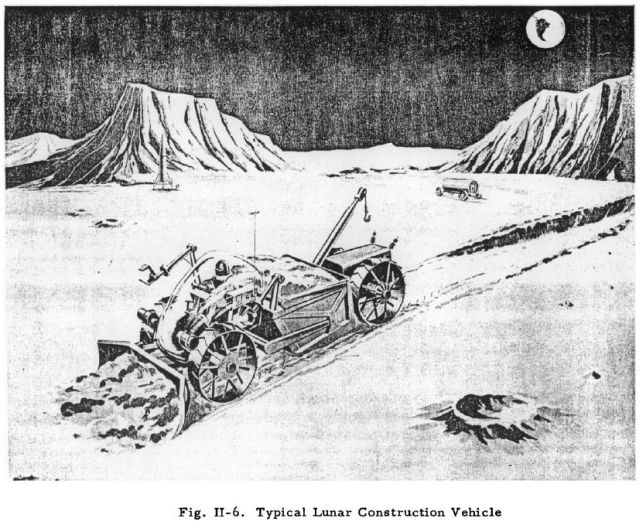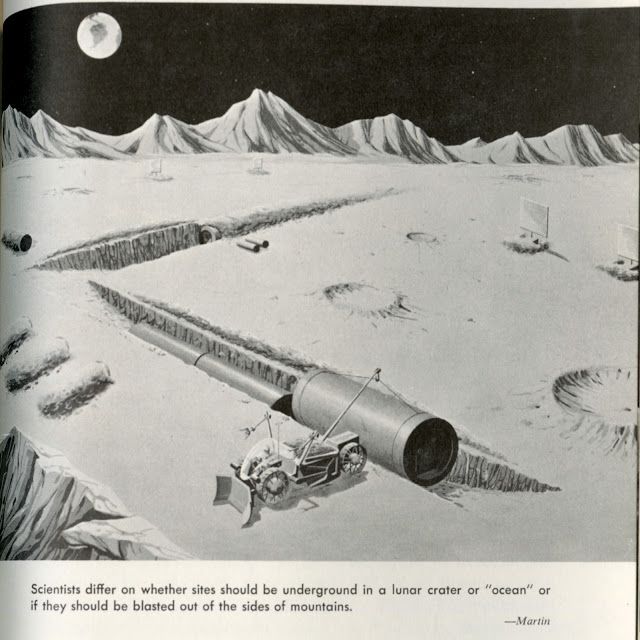Lunar Construction Vehicle with manipulator arms.
Above image from “The Next 50 Years on the Moon”, 1974.
NASA Study Summary: “Project Horizon, Vol 2, Technical Considerations and Plans”
Here’s a big study from 1959, done by the US Army, right about the time NASA was just becoming a going concern. There was a lot of interservice and interagency rivalry at the time with the AF and Army and Navy vying for the opportunity to dominate the space field– a field which Eisenhower SPECIFICALLY wanted the military excluded from to the extent possible… hence the creation of the civilian NASA in late 1958.
Here’s Project Horizon, the US Army’s plan to build a 12 man moonbase by 1965-66. The plan calls for the use of the ABMA’s Saturn booster (Saturn I) with an upgraded “Saturn II” to follow, using upgraded “H-2” engines (seriously upgraded H-1 engines from Saturn I). Project Horizon would also leverage existing technology by using the Titan I first stage as a second stage, and the Centaur, which was starting development by this time, as a third stage, with plans for an enlarged Centaur for the second and third stages of Saturn II and a smaller Centaur-based fourth stage for both rockets. It also planned to develop in-space refueling (what was later called “Earth Orbit Rendezvous” for the lunar mission, using several Saturn I and Saturn II launches to lift the fuel and equipment to orbit… which this report coming out of ABMA, which employed Von Braun and his team as the stars at the time, it only makes sense that this report closely mirrors Von Braun and Co.’s ideas about how to do a moon mission once Kennedy gave it the nod, though Houbolt proved that Lunar Orbit Rendezvous was the only way to do it within the decade target Kennedy set). The report even talks about the possibility of an 8 F-1 engined super booster that would later become known as NOVA. There’s also information about nuclear upper stages, which would supplement the Saturn I and Saturn II and F-1 superbooster and could end up landing as much as 420,000 lbs of cargo on the moon! There’s also a 2001 ring-like space station to serve as refuelling point for outbound lunar rockets, and several different lunar landers, all of which would use liquid hydrogen descent propulsion coupled with hypergolic ascent propulsion, later hopefully replaced with hydrogen ascent propulsion to improve performance. Even the idea of nuclear landers is thrown around…
A new equatorial launch center was to be built, most likely either on Christmas Island in the mid-Pacific, 2 degrees north of the equator, or on the Brazilian coast, 2 degrees south of the equator. The flightrate of Saturns to support the program was estimated at 5.3 launches PER MONTH! (ambitious, weren’t they!) Also, there were plans for two new space centers, one to do research on the basic problems of the designing the vehicles and their payloads and systems, the other having two facilities designed specifically to address the human factors and astronaut training and simulate the lunar and space environment. Basically this is the genesis of the idea for what became the Marshall Space Flight Center after the ABMA and it’s team and facilities were handed over to NASA from the Army by Eisenhower, to do the research into building the rockets and the systems to support them, and the astronaut training facility and human program research center (along with mission control) which later became the Johnson Space Center in Houston.
Source: Luke Strawwalker
See other early Space Teleoperators here.
See other early Lunar and Space Robots here.

